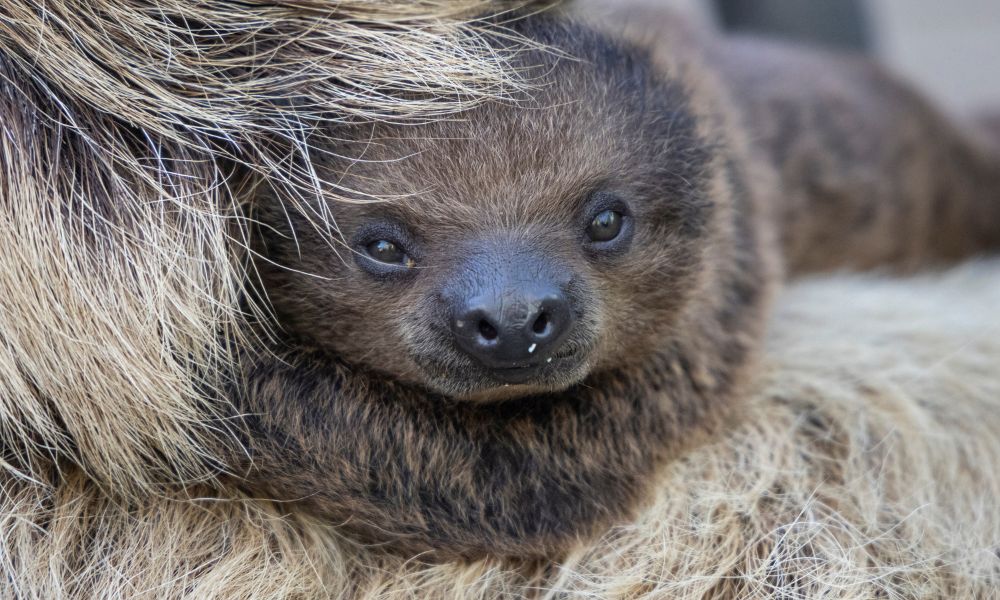Helping you find your next adventure!
Choose a State
SUBSCRIBE
ALABAMA
ALASKA
ARIZONA
ARKANSAS
CALIFORNIA
COLORADO
CONNECTICUT
DELAWARE
FLORIDA
GEORGIA
HAWAII
IDAHO
ILLINOIS
INDIANA
IOWA
KANSAS
KENTUCKY
LOUISIANA
MAINE
MARYLAND
MASSACHUSETTS
MICHIGAN
MINNESOTA
MISSISSIPPI
MISSOURI
MONTANA
NEBRASKA
NEVADA
NEW HAMPSHIRE
NEW JERSEY
NEW MEXICO
NEW YORK
NORTH CAROLINA
NORTH DAKOTA
OHIO
OKLAHOMA
OREGON
PENNSYLVANIA
RHODE ISLAND
SOUTH CAROLINA
SOUTH DAKOTA
TENNESSEE
TEXAS
UTAH
VERMONT
VIRGINIA
WASHINGTON
WEST VIRGINIA
WISCONSIN
WYOMING
- CLOSE LIST -
San Diego Zoo Welcomes Birth of a Linné’s Two-toed Sloth
The San Diego Zoo has announced the birth of a Linné’s two-toed sloth at the Zoo’s new Denny Sanford Wildlife Explorers Basecamp. The baby sloth, a female, was born June 25 to mother Xena (pronounced Zee-na), who was born at the Zoo in 2013 and is one of the Zoo’s most popular Rady wildlife ambassadors. Wildlife care specialists report that the young sloth is doing well, instinctively clinging to her mother, nursing, and gaining strength each day.
“We are thrilled and honored to have this baby sloth in our care,” said Clint Lusardi, wildlife care manager, San Diego Zoo. “She was a large baby at birth and is developing quickly. She started eating solid foods on day three which is normally not seen until day ten.” Lusardi added, “Xena is taking excellent care of her baby as it continues to grow and thrive every day. Our team of wildlife care specialists have been interacting with Xena and the baby from day one and we are proud to slowly start introducing the little one to our guests, giving them the chance to learn about this amazing species”
Native to the tropical and cloud forests of Central and South America, sloths are slow-moving, nocturnal creatures that spend almost their entire life upside down in the trees. They eat, sleep, mate, and give birth from this position, using their curved, sharp claws to hang onto the tree branches.
Sloths have long had a reputation for being lazy. The reason they move so slowly has a lot to do with what they eat: a variety of leaves, stems, buds and some fruit. Due to the low nutritional value of their leafy diet, sloths usually move at a leisurely pace and sleep a great deal, looking for food at night.
This baby sloth has spent the past month bonding with its mom. She will nurse for about six months, she began eating solid foods at just a few days old and was hanging upside down on her own at around 25 days of age. As wildlife ambassadors for their species, guests may see Xena and her baby during a wildlife presentation at the Rady Ambassador Presentation Area in Wildlife Explorers Basecamp or during an Exclusive VIP Experience—a special five-hour, upgraded Zoo tour.
The birth of this sloth was a result of a breeding recommendation from the Association of Zoos and Aquariums (AZA) Species Survival Plan (SSP), designed to help maintain a healthy assurance population of this species. Linné’s two-toed sloths are classified as a species of Least Concern on the International Union for Conservation of Nature (IUCN) Red List of Threatened Species. Threats to sloths include deforestation and other forms of habitat destruction, as well as human-made threats including power lines and roads.
Now through Sept. 5, Nighttime Zoo offers guests the chance to explore the Zoo at night and see an array of wildlife from a different perspective, enjoy live entertainment, discover special culinary treats and more. Nighttime Zoo also provides explorers of all ages the chance to see the new Denny Sanford Wildlife Explorers Basecamp. This 3.2-acre environment blends immersive technology with opportunities to check out extraordinary wildlife species. For more information on Nighttime Zoo and how you can be an ally for wildlife, visit sandiegozoo.org.


August 5, 2022
Be the first to comment